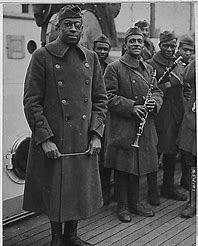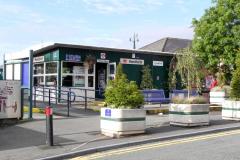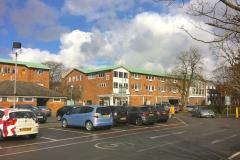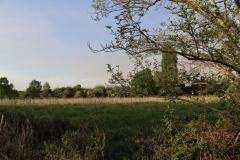
The first 3 months of the German "Spring offensive" represented the peak of enemy success. However, they had exacted a toll that their army could ill afford - fatalities in élite divisions that contained highly trained, irreplaceable "storm troopers". They now had to defend an extensive front over a wasteland of previous battlefields. Even more ominously Allied losses were increasingly being covered by US troops who in May alone had arisen from 430,000 to 650,000.
There was something of a lull now for the British. The Americans had first attacked at Cantigny on 28th - 29th May. More importantly on 3rd June the US 3rd Infantry Division was involved in action east of Chateau Thierry and later at Belleau Wood. Inexperienced but enthusiastic, the appearance of the GI's buoyed both civilians and Allied troops alike. The German Blűcher-Yorck offensive (the 3rd Aisne) spluttered to an end on 3rd June before they launched their 4th offensive (the Noyen-Didier or Griesenau) on the 9th towards Paris. But the French defence in depth and the American counter-attacks caused it to wither after just 4 days and a gain of 6 or so miles.
The American Expeditionary Force - called since the Mexican War of 1846 - 48 "Doughboys" - had been arriving for some time. By the summer of 1918 they numbered 2 million. Once here they were mostly being trained over 2 months or so by battle hardened British, Australian or Canadian officers and NCO's. Of the draftees 13% were Afro-American. Most were used in backbreaking labour, but as many American whites refused to fight alongside blacks, the minority allowed to fight were often attached to the French who had no qualms about going into battle with them. The most famous group was the 369th Infantry Regiment or "Harlem Hellfighters" led by their white commander Colonel William Hayward, who spent 191 days in the front line (more than any other American unit). Private Henry Johnson was awarded the Croix de Guerre in May as were 100 of his comrades. Their famous band also helped bring jazz to Europe under their leader James Rees Europe, the son of a slave.
Although the British were not involved in any major offensive or attack our community nevertheless lost 4 young men this month. On the 1st June Gunner John Thomas Earlam of "D" Battery 17th Brigade Royal Field Artillery (155141) died aged 33. The son of Isaac and Martha of 12 Farm Fold, Styal, he was by the time of the war the husband of Mary Elizabeth (née Hill) of Rose Cottage, Duke Street, Wellington, Shropshire. They were married in 1907 and had one son. John is buried at Morbecque British Cemetery, north of Béthune. He is remembered on Styal Memorial, in the local Methodist church and on a family grave in St Bart's churchyard. He was the eldest of 4 and worked as a domestic gardener before enlisting.
On 6th June Captain Frederick Arthur Jervis Eastwood of "D" Battery 103rd Brigade Royal Field Artillery died of wounds aged 22. He was born in Handforth in 1894, the son of Annie M and Thomas C, a barrister of Highfield, Wood End, Styal. In 1911 he was a boarder at Sedbergh public school. He is buried in Ferme-Olives Cemetery Belgium and is mentioned on a family grave at Dean Row.
The Wilmslow and Alderley Advertiser of 12th July published the following notice: "official news has been received that Sergeant Henry Morrell MM of the Army Service Corps, Mechanical Transport Company (M2/119391) has died of sickness". He had been at the front for nearly 3 years and was awarded the Military Medal for bravery. He had been born in Morley in 1886, the youngest son of the late Isaiah and Martha (née Mottershead) Morrell of 23 Racecourse Road, Lindow Common. In 1911 Henry was a chauffeur living in lodgings in Alma Road, Southport and he married Fanny Louise Parker in 1912. They had 2 daughters Louisa (1912) and Nellie (1914). He had lost a cousin, Frederick, at Gallipoli in 1915. Joining up early in 1914 his driving skills ensured he was assigned to the MTC. He died on 20th June and is interred at Aubigny Communal Cemetery Extension, north west of Arras and commemorated at St Bart's, Morley Green and the Wilmslow civic memorial.
On 26th June Private Alfred Rathbone of the 1/1 East Lancs Field Ambulance Royal Army Medical Corps, (69237) was killed in action aged 24. He was born in Withington and in 1901 was living in Cheadle with his stepfather Emmanuel Maynard and his mother Emily Mary. When he is enlistedin 1915 he was a dairyman at Stockton Farm, Wilmslow. He is buried at Bertrancourt Military Cemetery, Picardy and remembered in St John's and on the Wilmslow civic memorial.
Ever the gambler, Ludendorff was destined to roll the dice just once more in July 1918 attacking near Reims.
Jon Armstrong and Alan Cooper, Wilmslow Historical Society










Comments
Here's what readers have had to say so far. Why not add your thoughts below.
Thank you, Wilmslow Historical Society for bringing their stories to life for us.